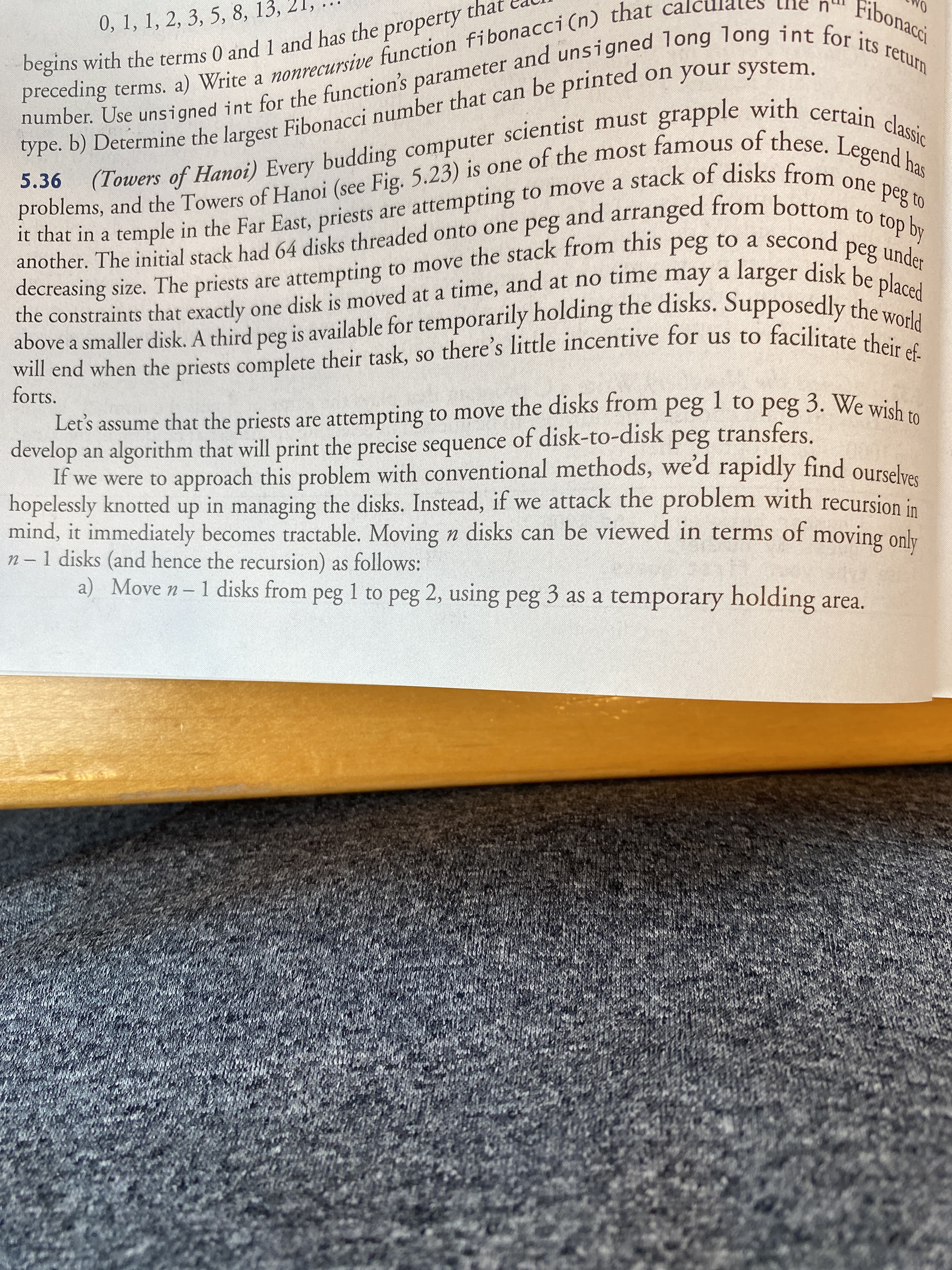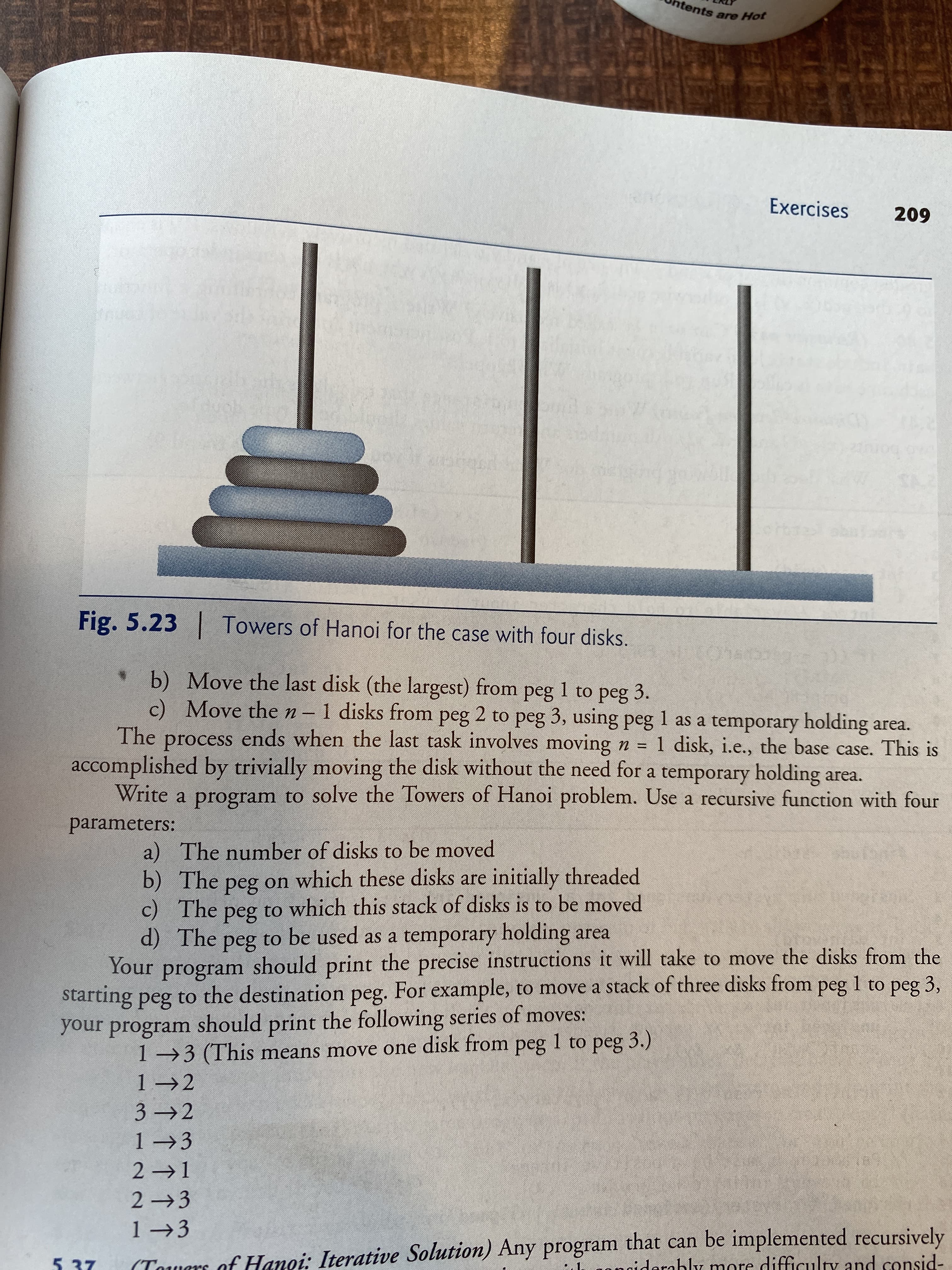begins with the terms 0 and 1 and has the property t preceding terms. a) Write a nonrecursive function fibonacci(n) that 0, 1, 1, 2, 3, 5, 8, 13, number. Use unsigned int for the function's parameter and unsigned long long int for its return grapple with certain classic Lype. b) Determine the largest Fibonacci number that can be printed on your system. problems, and the Towers of Hanoi (see Fig. 5.23) is one of the most famous of these. Legend has It that in a temple in the Far East, priests are attempting to move a stack of disks from8end top by Pe to (Towers of Hanoi) Every budding computer scientist must 5.36 decreasing size. The priests are attempting to move the stack from this peg to a second peg under above a smaller disk. A third peg is available for temporarily holding the disks. Supposedly the world another. The initial stack had 64 disks threaded onto one peg and arranged from bottom the constraints that exactly one disk is moved at a time, and at no time may a larger disk will end when the priests complete their task, so there's little incentive for us to facilitate their ef- forts. Let's assume that the priests are attempting to move the disks from peg 1 to peg 3. We wish develop an algorithm that will print the precise sequence of disk-to-disk peg transfers. If we were to approach this problem with conventional methods, we'd rapidly find oursel hopelessly knotted up in managing the disks. Instead, if we attack the problem with recursion in mind, it immediately becomes tractable. Moving n disks can be viewed in terms of moving only n – 1 disks (and hence the recursion) as follows: to a) Move n-1 disks from peg 1 to peg 2, using peg 3 as a temporary holding area. htents are Hot Exercises 209 Fig. 5.23 Towers of Hanoi for the case with four disks. Chato b) Move the last disk (the largest) from peg 1 to peg 3. c) Move then-1 disks from peg 2 to peg 3, using peg 1 as a temporary holding area. The process ends when the last task involves moving n = accomplished by trivially moving the disk without the need for a temporary holding area. Write a program to solve the Towers of Hanoi problem. Use a recursive function with four 1 disk, i.e., the base case. This is parameters: a) The number of disks to be moved b) The peg on which these disks are initially threaded c) The d) The peg to be used as a temporary holding area Your to which this stack of disks is to be moved peg program should print the precise instructions it will take to move the disks from the starting peg to the destination peg. For example, to move a stack of three disks from peg 1 to peg 3, your program should print the following series of moves: 1→3 (This means move one disk from peg 1 to peg 3.) 1 →2 3 2 1 →3 2 1 2 3 1 →3 (Towars of Hanoi: Iterative Solution) Any program that can be implemented recursively ngiderably more difficulty and consid- 5. 37
begins with the terms 0 and 1 and has the property t preceding terms. a) Write a nonrecursive function fibonacci(n) that 0, 1, 1, 2, 3, 5, 8, 13, number. Use unsigned int for the function's parameter and unsigned long long int for its return grapple with certain classic Lype. b) Determine the largest Fibonacci number that can be printed on your system. problems, and the Towers of Hanoi (see Fig. 5.23) is one of the most famous of these. Legend has It that in a temple in the Far East, priests are attempting to move a stack of disks from8end top by Pe to (Towers of Hanoi) Every budding computer scientist must 5.36 decreasing size. The priests are attempting to move the stack from this peg to a second peg under above a smaller disk. A third peg is available for temporarily holding the disks. Supposedly the world another. The initial stack had 64 disks threaded onto one peg and arranged from bottom the constraints that exactly one disk is moved at a time, and at no time may a larger disk will end when the priests complete their task, so there's little incentive for us to facilitate their ef- forts. Let's assume that the priests are attempting to move the disks from peg 1 to peg 3. We wish develop an algorithm that will print the precise sequence of disk-to-disk peg transfers. If we were to approach this problem with conventional methods, we'd rapidly find oursel hopelessly knotted up in managing the disks. Instead, if we attack the problem with recursion in mind, it immediately becomes tractable. Moving n disks can be viewed in terms of moving only n – 1 disks (and hence the recursion) as follows: to a) Move n-1 disks from peg 1 to peg 2, using peg 3 as a temporary holding area. htents are Hot Exercises 209 Fig. 5.23 Towers of Hanoi for the case with four disks. Chato b) Move the last disk (the largest) from peg 1 to peg 3. c) Move then-1 disks from peg 2 to peg 3, using peg 1 as a temporary holding area. The process ends when the last task involves moving n = accomplished by trivially moving the disk without the need for a temporary holding area. Write a program to solve the Towers of Hanoi problem. Use a recursive function with four 1 disk, i.e., the base case. This is parameters: a) The number of disks to be moved b) The peg on which these disks are initially threaded c) The d) The peg to be used as a temporary holding area Your to which this stack of disks is to be moved peg program should print the precise instructions it will take to move the disks from the starting peg to the destination peg. For example, to move a stack of three disks from peg 1 to peg 3, your program should print the following series of moves: 1→3 (This means move one disk from peg 1 to peg 3.) 1 →2 3 2 1 →3 2 1 2 3 1 →3 (Towars of Hanoi: Iterative Solution) Any program that can be implemented recursively ngiderably more difficulty and consid- 5. 37
C++ for Engineers and Scientists
4th Edition
ISBN:9781133187844
Author:Bronson, Gary J.
Publisher:Bronson, Gary J.
Chapter6: Modularity Using Functions
Section6.4: A Case Study: Rectangular To Polar Coordinate Conversion
Problem 6E
Related questions
Question
Question5.36. Answer in c

Transcribed Image Text:begins with the terms 0 and 1 and has the property t
preceding terms. a) Write a nonrecursive function fibonacci(n) that
0, 1, 1, 2, 3, 5, 8, 13,
number. Use unsigned int for the function's parameter and unsigned long long int for its return
grapple with certain classic
Lype. b) Determine the largest Fibonacci number that can be printed on your system.
problems, and the Towers of Hanoi (see Fig. 5.23) is one of the most famous of these. Legend has
It that in a temple in the Far East, priests are attempting to move a stack of disks from8end
top by
Pe to
(Towers of Hanoi) Every budding computer scientist must
5.36
decreasing size. The priests are attempting to move the stack from this peg to a second peg under
above a smaller disk. A third peg is available for temporarily holding the disks. Supposedly the world
another. The initial stack had 64 disks threaded onto one peg and arranged from bottom
the constraints that exactly one disk is moved at a time, and at no time may a larger disk
will end when the priests complete their task, so there's little incentive for us to facilitate their ef-
forts.
Let's assume that the priests are attempting to move the disks from peg 1 to peg 3. We wish
develop an algorithm that will print the precise sequence of disk-to-disk peg transfers.
If we were to approach this problem with conventional methods, we'd rapidly find oursel
hopelessly knotted up in managing the disks. Instead, if we attack the problem with recursion in
mind, it immediately becomes tractable. Moving n disks can be viewed in terms of moving only
n – 1 disks (and hence the recursion) as follows:
to
a) Move n-1 disks from peg 1 to peg 2, using peg 3 as a temporary holding area.

Transcribed Image Text:htents are Hot
Exercises
209
Fig. 5.23
Towers of Hanoi for the case with four disks.
Chato
b) Move the last disk (the largest) from peg 1 to peg 3.
c) Move then-1 disks from peg 2 to peg 3, using peg 1 as a temporary holding area.
The process ends when the last task involves moving n =
accomplished by trivially moving the disk without the need for a temporary holding area.
Write a program to solve the Towers of Hanoi problem. Use a recursive function with four
1 disk, i.e., the base case. This is
parameters:
a) The number of disks to be moved
b) The peg on which these disks are initially threaded
c) The
d) The peg to be used as a temporary holding area
Your
to which this stack of disks is to be moved
peg
program should print the precise instructions it will take to move the disks from the
starting peg to the destination peg. For example, to move a stack of three disks from peg 1 to peg 3,
your program should print the following series of moves:
1→3 (This means move one disk from peg 1 to peg 3.)
1 →2
3 2
1 →3
2 1
2 3
1 →3
(Towars of Hanoi: Iterative Solution) Any program that can be implemented recursively
ngiderably more difficulty and consid-
5. 37
Expert Solution
This question has been solved!
Explore an expertly crafted, step-by-step solution for a thorough understanding of key concepts.
This is a popular solution!
Trending now
This is a popular solution!
Step by step
Solved in 3 steps with 1 images

Knowledge Booster
Learn more about
Need a deep-dive on the concept behind this application? Look no further. Learn more about this topic, computer-science and related others by exploring similar questions and additional content below.Recommended textbooks for you

C++ for Engineers and Scientists
Computer Science
ISBN:
9781133187844
Author:
Bronson, Gary J.
Publisher:
Course Technology Ptr

C++ Programming: From Problem Analysis to Program…
Computer Science
ISBN:
9781337102087
Author:
D. S. Malik
Publisher:
Cengage Learning

C++ for Engineers and Scientists
Computer Science
ISBN:
9781133187844
Author:
Bronson, Gary J.
Publisher:
Course Technology Ptr

C++ Programming: From Problem Analysis to Program…
Computer Science
ISBN:
9781337102087
Author:
D. S. Malik
Publisher:
Cengage Learning